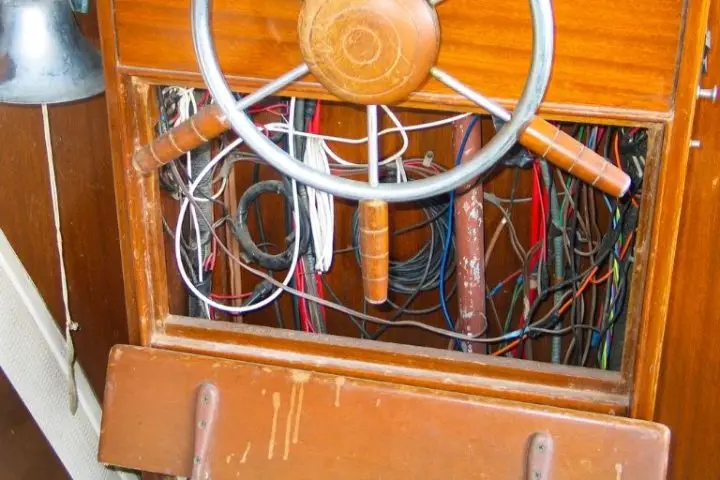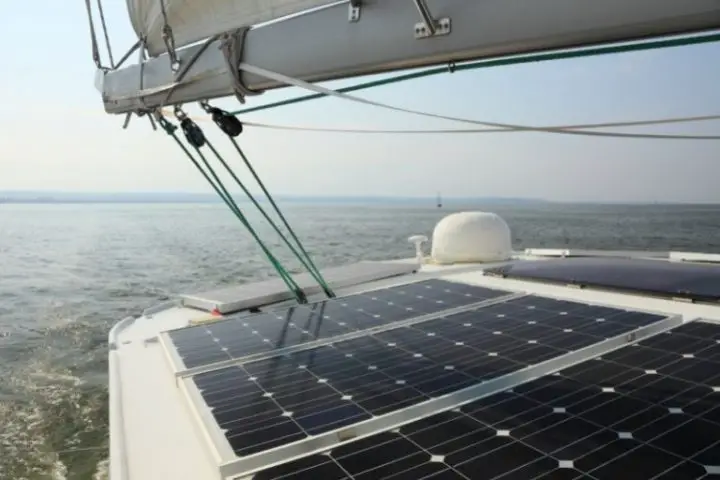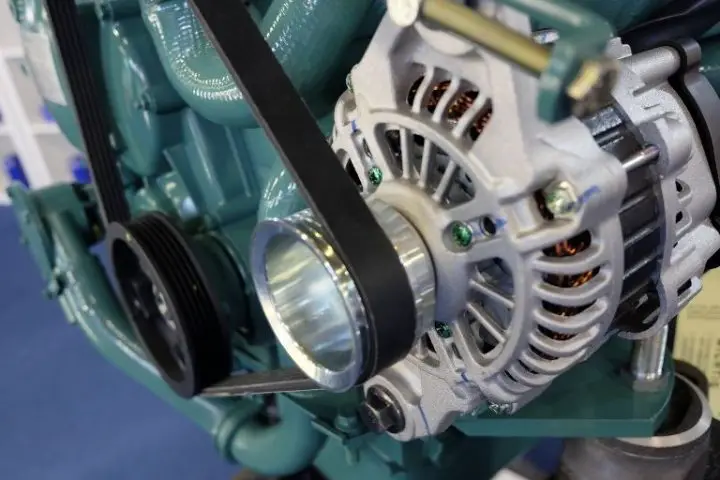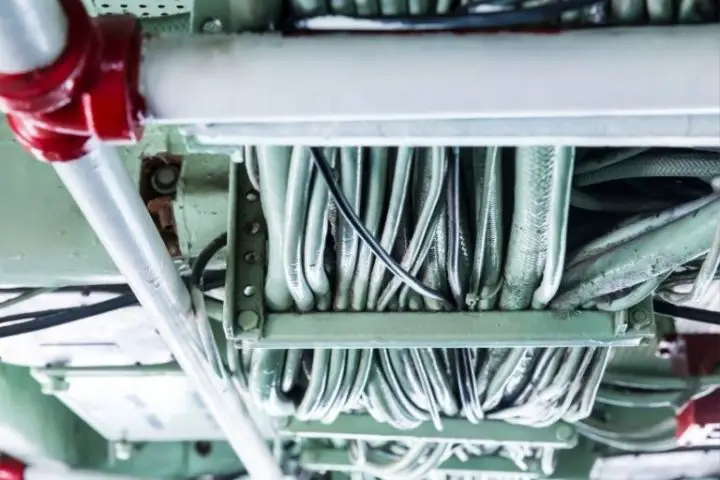One of the most complicated systems on your boat is the electrical and wiring system. No two boats are ever alike, and many owners will find occasional upgrades and add-ons that they want to put in themselves. But marine systems are not like those in your home or car—there are special procedures and things you need to watch out for.
Boats are unforgiving of shoddy installation and improper installations. Boats live in a corrosive environment that is always in motion. If that’s not enough to worry you, remember that nearly all boat fires are caused by electricity. Proper education and careful installation are vital for your safety on the water.
Table of Contents
- Overview of Marine Systems
- Electrical Basics
- Liveaboard Boat DC Power Systems Overview
- AC Power Systems Overview
- Unique Qualities of Marine Electrical Systems
- What is the Difference Between Marine Wire and Regular Wire?
- What Wire Size Should I Use to Wire my Boat?
- How Do You Run Wires on a Boat?
- Conclusion

Overview of Marine Systems
Boats have pretty complex electrical systems. Boats that are large enough to live on will have two types of systems. One system works just like those found in cars. This 12-volt system charges when the engine is running. When the engine is not running, a battery stores power for the next start and runs electrical equipment like lights.
The difference is that there are many more things that run on a boat. For example, many boat refrigerators and freezers work from the 12-volt battery system. All of the lights, navigation equipment, radios, fans, and other doodads also work from that system, draining the batteries when there is no charging source. This is the DC (direct current) system.
Additionally, most boats have a high-voltage system with standard outlets like a house. These are used when at a dock and connected to shore power. It allows you to run air conditioners, water heaters, blenders, hairdryers, irons, lamps, televisions, and a whole host of other things that you would normally use in your home. This is the AC (alternating current) system.
The AC system does not work on its own. Batteries are DC only—there is no way to store power for an AC system. So, if you aren’t plugged into shore power at a dock, you’ll need something to produce AC power for you. Or, you can ensure that everything you need when away from the dock is DC-powered.
There are two ways to get AC power easily away from the dock, but both have limits. One is to have an onboard generator, which makes AC power. Large boats often have inboard generators. Some boaters use portable gas generators on deck, though that is not without risks.
Another way to create AC power is to use an inverter, which turns DC power from the batteries into AC power. This is enough power to charge a laptop or run a blender, but to run a heavy consumer of electricity like an air conditioner, you would need an enormous amount of batteries and a huge inverter!
Electrical Basics
Before diving into the details of boat wiring, let’s look at some basics of electricity first.
Basic DC Circuits
Think of a flashlight as an elementary diagram of an electrical circuit. A single battery is connected to a light bulb with wires. There’s usually a switch or button to disconnect the power from the light when it’s not in use.
For the circuit to work, the light bulb must be sized correctly. If the light bulb requires six volts of power to illuminate, using one three-volt battery will not do. And if you accidentally installed a nine-volt battery, the bulb would likely explode!
Likewise, the wires must be suitable to carry to power requirements. If something uses a lot of electricity, it likely needs bigger wires.
The light will run as long as there is power in the battery. As the power is used up, the voltage the battery provides drops. When it drops below the six-volt threshold in our example, the light will no longer power on.
Series Versus Parallel Electrical Circuits
Some electrical tricks can be employed, each of which is useful in understanding boat systems. You can wire more complex systems in many ways, and how they are set up will have profound implications.
In our flashlight example, we have a six-volt light bulb. But standard batteries only come in 1.5-volt options. So how can we power the light with standard batteries?
The answer is to wire the batteries in series. If you put two batteries together end to end, the total system voltage will be their sum. Two 1.5-volt batteries make three volts. If you put four together end-to-end in series, the system will have six volts. The light bulb will work!
This addition comes at a price, however. Even though your light has four batteries in it, the excess power is being used to create higher voltage, not extra capacity. So it will still last as long as a single battery.
This is where parallel wiring comes in. If you put the batteries together side-by-side instead of end-to-end, their voltage will remain the same, but their capacity will increase. So, our flashlight would benefit from four more batteries wired side-by-side to the first set of batteries. This flashlight design would last twice as long and still produce six volts.
DC vs. AC Power
The flashlight example is a DC (direct current) system. Batteries produce direct current power. Electrons flow linearly from the negative terminal of the battery to the positive. If there is any break in the circuit, it will not function.
DC systems are rated based on the type of battery they use. Boats and cars, for example, usually have 12-volt systems. But some larger vessels have 24 or 48 volt systems. Every component of the system must be made to handle the voltage. So if your boat has a 48-volt system and you buy a 12-volt stereo, it’s going to be toast as soon as you plug it in.
Alternating current is the type of power that comes out of your wall outlet at home. Instead of a flow of power from one end to the other, an AC circuit is uniformly energized.
AC systems provide much higher voltages, and therefore much more power than DC systems. This is why they’re used in boats to run things like air conditioners, water heaters, or DC battery chargers. AC voltage is usually standardized for a country or geographic region. The US uses 120-volt, 60 hertz systems. Most EU countries use 240-volt, 50 hertz systems. The outlets and appliance plugs vary to give users a clue as to what is compatible with what.
The two forms of power are not at all compatible. An appliance that is designed for DC will blow up if plugged into AC power and vice versa.
Liveaboard Boat DC Power Systems Overview
Here’s a look at some of the typical components of the DC system on a liveaboard boat. A vessel this size is usually pretty complex, with some comforts from home. Refrigerators, fans, lights, and all sorts of other devices are likely connected to the same system.
The system often powers essential electrical equipment on the boat, making it one of the things you really shouldn’t neglect. The bilge pump, for example, requires its own circuit to ensure it will operate when needed.
Storage
Boat batteries are almost always 12-volt batteries that look like the ones put in cars. A boat usually has two sets of batteries, however. One battery is reserved just for the engine and for starting. The other battery or set of batteries is known as the house or domestic battery bank. This is used for powering all of the other systems.
The advantage of having two systems is that you can still start the engine if you accidentally run down your house bank. Some boats have a manual battery switch to change between the two banks, and the owner must make the change. Newer systems feature an automatic relay instead of a battery switch that protects the starting battery without any work on the part of the owner.
Since the house bank powers a lot of stuff, many boats have large banks. If a sailboat wants to operate its systems while sailing, there is no engine charging going on. At the same time, it will want to use the boat’s autopilot, radios, and navigation systems—all of which need battery power. By installing a large bank of batteries, they can operate for days without charging up.
Batteries are also rated in amp hours. This is a measurement of capacity. Simply put, if you drew that many amps, the battery will last one hour. So a 100-amp hour battery will last one hour if you’re using 100 amps or two hours if you’re using 50 amps.
Charging Source
How do boats charge their batteries? Like cars, nearly all boats charge when the engine is running thanks to the engine alternator.
If a boat has a shore power connection, it will likely have an AC battery charger, too. So at the dock, the batteries are charged by regular electricity.
Many boats have nothing more than these two systems. If you live at a dock and only go out for a day or two at a time, this works fine. But many owners want to at least extend their time between charges, especially if they like to stay at anchor or offshore sailing.
You can add all sorts of renewable charging options. The two main ways are solar and wind power. Solar panels can be added, which provide lots of power during the mid-day when the sun is strong. Wind generators add power when the wind is blowing.

Electrical Panel and Circuit Breakers
Now that you have batteries and they are topped up with power, you’ve got to use that electricity to power your stuff. Most boats have a centralized distribution switch panel where components are switched on and off.
An essential part of the distribution system is overcurrent protection. If a device has a short circuit and begins drawing a lot of power, you want the circuit to shut off before the device, or the wire starts a fire. On a boat made of flammable fiberglass and all sorts of combustibles like wood, gasoline, and diesel–it’s vital.
The most common form of overcurrent protection is the circuit breaker. These pop or trip open when something isn’t right, specifically when a certain amperage has been exceeded. On the distribution panel, they just look like big on-off switches. But if it ever shuts down on its own, it’s because the breaker has popped.
Almost as common is the use of a fuse for circuit protection. A fuse does the same job, but it’s a one-time thing. When a fuse pops, you have to replace it. Many types of fuses are common in marine applications, but spade-type and glass cylinder fuses are the most common.
From the distribution panel, individual wires take power to each consumer on its own circuit.
Electrical Equipment
Electrical consumers in boats can be anything. Many items you’re used to using at home have DC equivalents for car, RV, or boat use. For example, there are DC televisions, refrigerators, heaters, lights, and fans.
The boat has quite a few DC power consumers built in. Here’s a shortlist of the most common ones
- Navigation lights
- Cabin lights
- Bilge pump
- Water pump
- Refrigerators
- Navigational instruments
- Autopilot
- Entertainment items like radio, TV, etc
- 12-volt and USB power outlets (usually like a car—cigarette lighter style)
- Fans
AC Power Systems Overview
Alternating current cannot be stored in batteries, so the AC system on a boat only works when it has a constant supply of power.
Why Have AC Power At All?
You may look at the list of DC power consumers and wonder why they have AC power at all. Plenty of boaters make do with DC-only systems on their boats.
But AC power provides a few very nice luxuries. Some items use so much power that batteries cannot run them, or at least not for very long. The number one example is air conditioning and heating.
Many people also find it convenient to be able to run normal household appliances from the boat. If you’re living aboard, you’ll need to power your laptop or charge your phone. Twelve-volt phone chargers are common, but 12-volt laptop chargers are hard to find.
There are other things you might want to use, like a blender or hairdryer. You probably can’t find 12-volt options for everything you use at home.
Here are a few items that are common on boat AC systems.
- Battery charger
- Air conditioning
- Heaters
- Water heaters
- Power outlets
For boats that seldom leave shore power or that have large generators, they may use more AC appliances, like the following.
- Electric stove or oven
- Microwave
- Barbecue grills
- Refrigerators and freezers
Shore Power Connections and Circuit Breaker
If a boat has AC power onboard, then it will always work when plugged into the dock. Because the shore power cord powers the entire boat, it is a large connection with a large plug. Shore power cords are rated for either 30, 50, or 100 amps. Each cord and plug is progressively larger than the next.
Shore power connections are often a significant problem and sometimes even a fire hazard. The cord plugs are prone to corrosion, and wave action and movement can cause bad connections even in marinas. Therefore, shore cords need to be inspected and replaced regularly.
Like all electrical equipment on a boat, the shore power connection should be protected with circuit breakers. There should be one on the power pedestal providing power to the boat and one near where power enters the boat.
Generators
If you want to have constant AC power while not plugged into shore power, you’ll need a generator. Generators run on either gas or diesel, and they can be built into the boat or portable units you store on deck.
Portable generators are less than ideal on boats, and in some cases, they can be deadly. Portable gas generators produce carbon monoxide, a deadly gas. Since boats are such small spaces, it can be challenging to ensure that all carbon monoxide is being vented overboard. Never use a gas generator in an enclosed or semi-enclosed area.
Inboard generators are every bit as large, complex, and expensive as your main propulsion engine. Like the main engine, they require routine maintenance and servicing. If you run your generator to power air conditioning, you’re likely to run it all the time you are not plugged into shore power.
Besides running high-load items like air conditioning or water heaters, generators also run battery chargers to repower your DC battery bank. So if you’re away from shore and happily using only DC power, you can recharge by starting up the generator for a few hours.

Inverters
If you’re away from shore power and need to use just a small amount of AC power, you can use an inverter. This is a DC appliance that pulls power from the batteries and makes AC power.
Inverters are rated in watts. Some are small and designed to plug into a 12-volt cigarette lighter outlet to power a single item, like a laptop charger. Others are large, designed to be wired into the boat and power all outlets.
The size and complexity of the inverter you choose depends on how much you need to use it. If you want to run kitchen appliances, you’ll likely want something 1,500 watts or larger. Of course, a large inverter like this will require a substantial battery bank to run it.
If your general idea is to only power a laptop or a few small items, you can get away with something as small as 200 or 500 watts.
Unique Qualities of Marine Electrical Systems
ABYC Recommendations and Procedures
The American Boat and Yacht Council is an industry trade group that lays out standards for marine systems. Their recommendations for electrical systems are essential. Unfortunately, the exact requirements are not available to DIYers and non-members. They do have some free courses and information on their website, however.
It’s important to familiarize yourself with these standards as much as possible. These standards have been created as best practices—because other methods have proven ineffective or dangerous.
Furthermore, while you might not care if your boat is up to these standards or not, chances are the buyer will care very much when you go to sell it. A survey is a normal part of the purchase process, and insurance companies will want to see the results before they underwrite a boat. If a surveyor says that your electrical system does not meet boat and yacht council standards, the boat may be uninsurable. An uninsurable boat is likely unsellable.
Before setting out to do any work on a boat electrical system, find some trusted resources to learn from. Don’t trust other new boaters or the things you find on the internet. If you’re completely unfamiliar with electrical systems, hire an ABYC-certified marine electrician.
What is the Difference Between Marine Wire and Regular Wire?
There are many differences between boat systems and home or automobile electrical systems. One of those is the most basic thing you can imagine—the wires.
Marine wires are designed with two factors in mind that no other application has to deal with. Firstly, they are designed to withstand vibrations. To do this, a single marine wire is made up of many strands of copper wire. The strands are tiny, which makes the wire flexible. It also means that vibrations will not deteriorate it, as would be the case with solid copper wire.
The next thing marine wire needs to be able to handle is life in a corrosive environment. The copper strands of marine grade wire are tinned to prevent corrosion.
Neither of these two factors is easy to find. Most wire and cable you find at the local hardware store will be solid copper. Many automotive stores sell stranded wire, but it’s not tinned. Neither of these options is appropriate for marine use.
So while it is expensive, there really is no substitute for proper tinned and stranded marine wire and cable.
When working with marine cable, it’s vital to use good quality tools and marine grade wire terminals. Marine wire terminals are tinned, too–and they are nearly always crimped, not soldered or twisted. If the connection is made in a damp environment, heat shrink will protect the connection from corrosion.
What Wire Size Should I Use to Wire my Boat?
Every wire you run in your boat is basically custom-sized for the task at hand. There is no one-size-fits-all solution. Wire size is measured wire gauge, ranging from large 4/0 battery cables down to tiny 22 AWG wires.
To calculate wire size, you must look at the load the wire will carry, the total length of wire run (including the return path), and the desired voltage drop. All wires will cause some amount of voltage drop.
There are tables published in many textbooks about marine wiring. There are also online calculators, like this one from Blue Sea Systems.

How Do You Run Wires on a Boat?
Running wires through the tight compartments on a boat is an exercise in patience and care. It all depends on the boat’s design and the actual compartments the wire needs to travel through.
Per ABYC standards, a wire should be supported through its entire run, and it should be protected from chafe when passing through holes and bulkheads. Many boat makers provide channels or tubes for the running of wires. In some cases, these may have messenger lines run through them.
The basic steps of running a new cable start with identifying the best route for the cable and then breaking it into manageable sections. For each section, you’ll make a plan. Sometimes, you just need to install wire supports. For others, you’ll need to run the wire through tight passages.
If you have run the wire through a tight passage, an electrician’s wire fish and some wire lubricant are invaluable. A piece of small-diameter stainless wire rope will do in a pinch. With the fish, run a messenger line through the passage. Then, attach the messenger to the wire with electrical tape and secure knots. Keep the junction as smooth and tapered as possible to avoid snags. Finally, pull the messenger to get the cable through the passage.
Always note if there are spots where the wire rubs against wood, metal, fiberglass, or other cables. With the movements of a boat, these spots can rub the coating off of wires in no time, causing shorts and a fire hazard. Use a chafe guard in these spots. Rubber grommets or flexible tubing work well.
Conclusion
Marine electrical systems are complicated, and before diving into doing any work on them, you should definitely invest some time learning about what makes them different from home or automotive circuits. There are plenty of projects that are well within the abilities of DIY boat owners, but only after fully understanding the fundamentals of marine wiring. There is no replacement for marine grade wire, wire terminals, or the proper tools.
If you’re new in the world of sailing, check out my post on Best Boat for Beginners for ideas where to start!
